The Mac Pro Review (Late 2013)
by Anand Lal Shimpi on December 31, 2013 3:18 PM ESTSSD
The new Mac Pro does the right thing and abandons internal hard drives in favor of high-speed PCIe based storage. You could argue wanting more internal PCIe storage, but hard drives don’t belong inside this machine - for that there’s Thunderbolt 2.
There’s a single proprietary Apple PCIe SSD connector and module inside the new Mac Pro. The connector looks similar to what’s in the new MacBook Pro but I haven’t verified compatibility. Unlike the new MacBook Pros, the Mac Pro SSDs only ship in a x4 PCIe configuration. The result is faster peak sequential speeds.
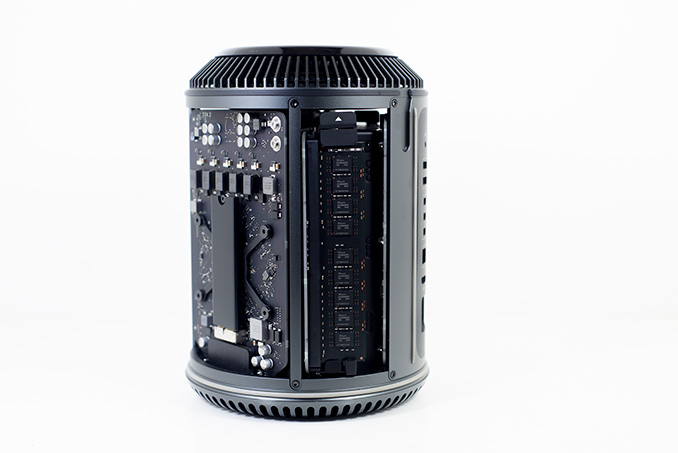
Custom SSD behind the GPU board on the left
My review sample had a 512GB Samsung XP941 based drive. I believe this is a 2-bit-per-cell MLC design with a 512MB LPDDR2-1066 DRAM. Samsung’s SSD architectures have evolved pretty well over the years. As long as you’re careful not to completely fill the drive you should be ok from an IO consistency standpoint as well. I continue to recommend keeping around 15 - 20% of the SSD free if you want to keep performance at a relatively high level. Definitely keep this in mind if you’re torn about what capacity drive you should outfit your system with.
| Mac Pro (Late 2013) SSD Options | ||||||
| 4-Core Config | 6-Core Config | |||||
| 256GB | Included | Included | ||||
| 512GB | +$300 | +$300 | ||||
| 1TB | +$800 | +$800 | ||||
Apple offers three SSD capacities with the new Mac Pro: 256GB, 512GB and 1TB. Both default configurations come with a 256GB drive. Upgrades to 512GB/1TB cost the same regardless of your starting point: $300 and $800, respectively. Chances are you’re going to depend fairly heavily on external storage for media, which leaves you the flexibility of sticking with the base 256GB configuration. Personally I’d use the Mac Pro just as much as a regular PC (including gaming) as I would for photo/video work, so I’d push for the highest capacity SSD possible. Since Apple isn’t using a standard connector or form factor here, you can’t necessarily count on anyone offering a decent aftermarket solutions (although OWC has done so in the past). If OWC or anyone else was brave enough to produce an aftermarket Mac Pro SSD, it might come with fewer tradeoffs compared to what we’ve seen in the portable Mac space. I’m primarily talking about ultra low idle power not being as much of an issue for an SSD in the Mac Pro. Last time I looked, OWC’s aftermarket MacBook Air/Pro SSDs consumed more power at idle compared to the Apple OEM drives. The same issues wouldn’t matter in a Mac Pro.
I ran the 512GB SSD through our standard four-corners Iometer test suite. The numbers were expectedly a bit higher than what I measured on the 15-inch Haswell rMBP and the 21.5-inch Haswell iMac thanks to the drive’s PCIe x4 interface. Random write performance takes a step backwards but all of the results we're showing here are more than enough for single user workstation use. Although Mavericks itself seems to have issues that can cause high latency IO (particularly around quicklook), the SSD in the Mac Pro performed quite well.
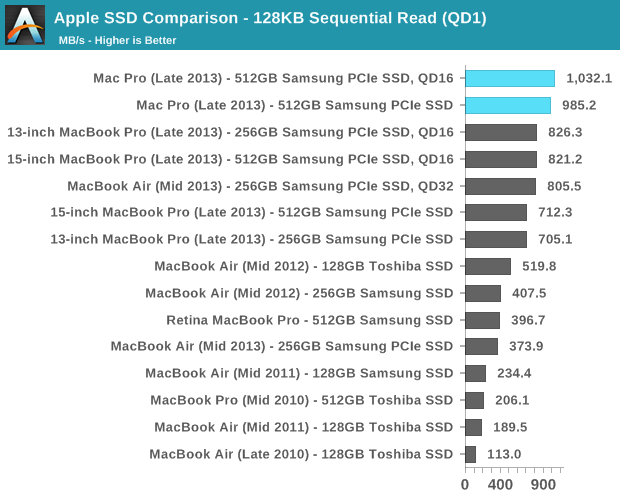
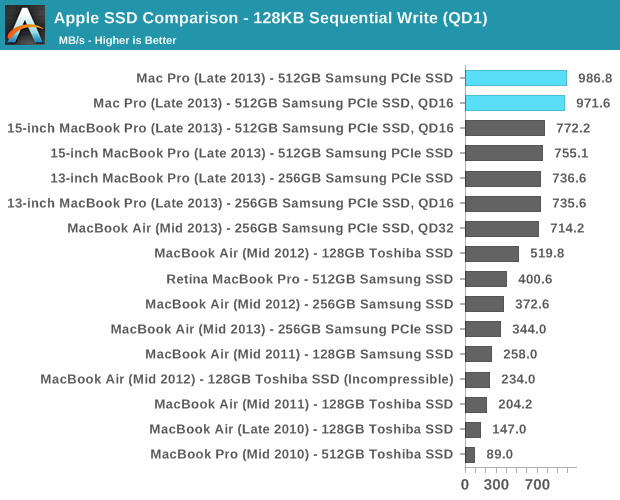
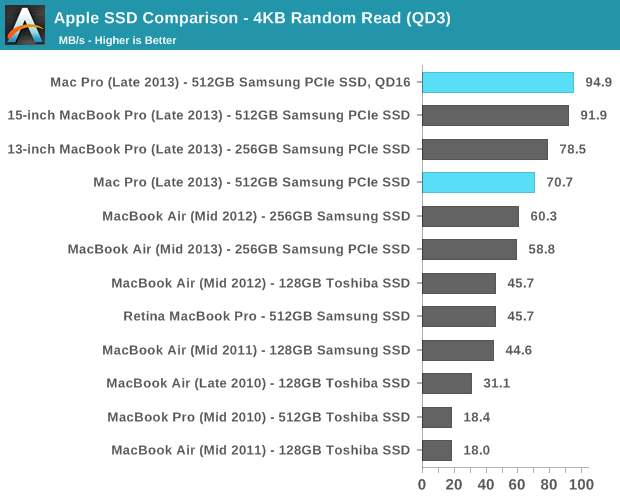
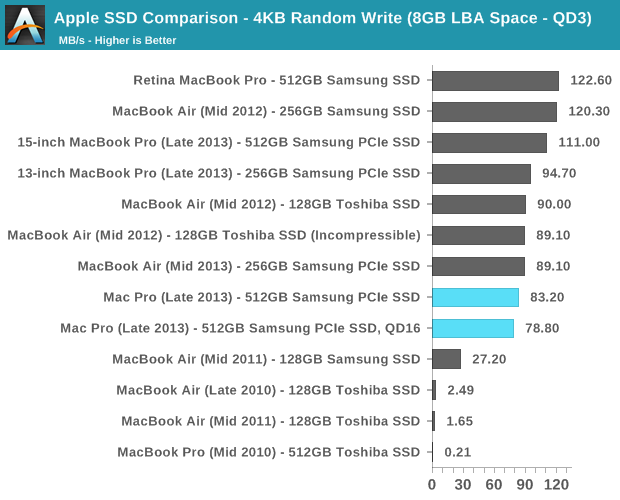
I’m beyond pleased to see that Apple has moved its Mac lineup virtually top to bottom to PCIe SSDs. This is absolutely the right approach, and one that all other OEMs should follow.
Gigabit Ethernet & WiFi
Broadcom won all of the networking sockets in the new Mac Pro. Each machine ships with two BCM57762 Gigabit Ethernet controllers and a BCM4360 802.11ac controller. Each controller is connected to its own PCIe 2.0 x1 lane, guaranteeing it more than enough bandwidth to operate at full speed. The GigE ports on the back of the Mac Pro are thus independent and can sustain full bandwidth in tandem.
The 802.11ac solution is the same 3-stream BCM4360 you’ll find in the new Haswell MacBook Pros. The Broadcom controller supports 80MHz wide channels and 256 QAM, resulting in a peak theoretical data rate of 433Mbps per stream. With three streams that works out to be a max negotiated PHY rate of 1.3Gbps.
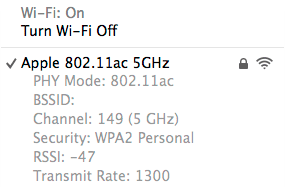
In practice I found the Mac Pro’s WiFi performance in best conditions to be similar to that of the 21.5-inch 2013 iMac, which ships with the same hardware. Over UDP that amounts to just under 900Mbps, and a bit over 600Mbps over TCP. You’re still better off using GigE if you can, but 3-stream 802.11ac is arguably good enough if you can’t get a cable down to your Mac.
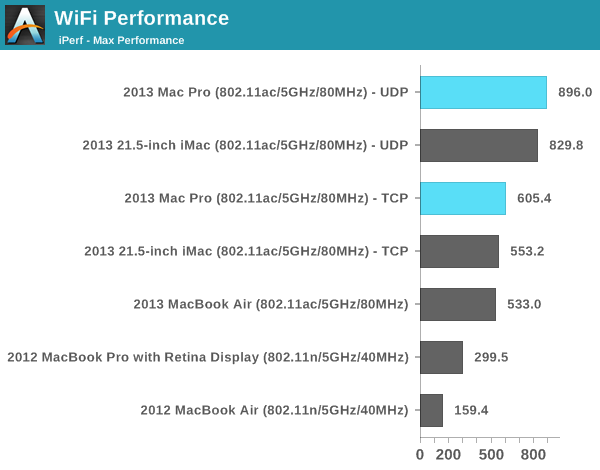











267 Comments
View All Comments
LorneKwe - Friday, January 3, 2014 - link
How about we replace those Quadro 6000's with Radeon 7970s which are what the Mac Pro has inside. You can make any price comparison look like shit when you erroneously drop a few thousand dollars worth of GPUs into the build.Dual 6GB 7970s cost $1,400.
Using that, we can build out a 24C Dual Xeon 2697v2 workstation, with 64GB of RAM, dual 512GB 840 Pro SSDs in RAID0, H100i cooling on each CPU, and it would come to around $10,000. Same price as the Mac Pro's kitted out, 12C config, double the CPU power, and a good chunk more GPU power as they aren't underclocked.
You also have the option of going with 4x 7970s if you chose to, and if you forgo to ASUS Z9PE board for a proper workstation board, you can go up to 512GB of RAM instead of being capped at 64GB. If you want dual Quadro K5000s instead of 7970s, raise the PC's price by around $1600, but understand that these will outperform Apple's D700 pair by an enormous margin.
If you're looking for portability, or absolutely require OS X for what you do; choose the Mac Pro. If you're looking for computer power that won't throttle down when faced with tough workloads; have a full-fledged workstation built for you and get much more bang for your buck.
stingerman - Sunday, January 5, 2014 - link
Sorry Dude, this is a Pro Workstation, that mean workstation class GPUs. 7970 is a great CPU but there is a reason it doesn't go into Workstations...madwolfa - Sunday, January 5, 2014 - link
And what is it? Drivers? D700s in Mac Pro don't even have ECC memory enabled in them.wheelhot - Monday, January 6, 2014 - link
yes, the drivers provided (and I believe you can only test this in Windows?) will determine if it's actual workstation class GPUs or just Radeons with the name FirePro slapped on it. I'm seriously hoping it's supplied with actual workstation GPU driver, as it'll greatly benefit the software I use.LorneKwe - Tuesday, January 7, 2014 - link
I'd agree with you if we didn't have solid evidence that Apple's D700 is a repurposed 7970; lack of ECC memory being the best clue, and pricing being a great clue as well.scarhead - Saturday, January 4, 2014 - link
One Xeon E5-2697 processor costs $2,614. Two costs $5,228. I doubt your $3,712 figure for complete system is accurate.p51mustang6 - Thursday, January 2, 2014 - link
Apparently any comment disagreeing with the author gets deleted.chaos215bar2 - Friday, January 3, 2014 - link
Clearly not. Perhaps your comment was rude, trolling, and / or being argumentative without actually adding anything to the discussion?Johan Niklasson - Friday, January 3, 2014 - link
Great review - thanks. I just wanted to add that the new Mac Pro design and its finish does matter more than most people understand. The ones who work on graphic and video applications usually are artists with some sense of beauty and aesthetics. I am sure that the much more pleasant looking Mac Pro is a welcome addition to such people's workspaces.Also the smaller form factor and the silence will make it hard to resist!
james-bond - Friday, January 3, 2014 - link
Thanks for the great review. I wonder if some of the USB ports should have been on the other side of the chassis. Seems like the power cord and monitors are things that are rarely unplugged and are usually on the back side of current case designs. Having to reach around to plug and unplug a flash drive seems inconvenient.Please keep and eye out for an upgrade to Logic Pro (Apple's audio pro app). A would love for you to benchmark this in the same way you did Final Cut. I doubt Apple will be able to harness the second GPU for compute in audio applications do to latency in doing real time audio monitoring. Audio has taken a back seat to video apps in this version of the Mac Pro it seems.